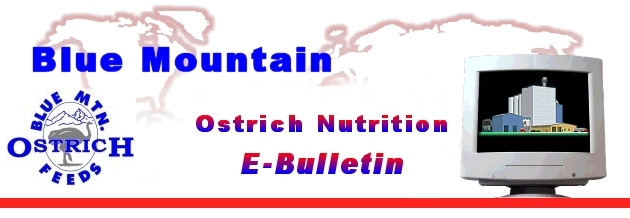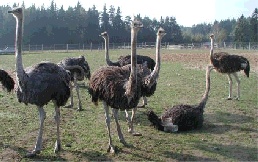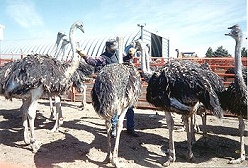

October 8, 2002
Bulletin #85
Table of contents:
Special Bulletin of the Month
Report on World Ostrich Congress - 2002
By: Fiona Benson, Blue Mountain International
Our e-mail address
Subscribe – Unsubscribe information
Special Bulletin of the Month
Report on World Ostrich Congress - 2002
World Ostrich Congress 2002
Warsaw, Poland, September 26 - 29, 2002
The Congress this year was well attended with some 400 delegates from many countries…from Chile to China, USA to Thailand…several of the major producing countries, such as Australia, Zimbabwe and Namibia were not present. Delegates will have attended in the hope of learning new things, developing business relationships, sharing experiences and making new friends. Most important of all to learn what is required to develop their own Ostrich business whether they are producers, processors, and/or marketers of end products. Some delegates were just starting out, but most have been involved with the industry for some years now.
The first night saw the meeting of the regenerated European Ostrich Association, to be renamed the European Ostrich Council, and the new World Ostrich Association…more of that later.
On the marketing side a number of papers hit on the key factor currently limiting market growth:
Inconsistency of Products, Inconsistency in Supply and Insufficient Volume
Resulting in many potential markets being unavailable
Several speakers highlighted the major contributing factors:
1. Poor Breeder performance and High Levels of Chick Mortality
2. Lack of Standards
One speaker suggested, once again, the need to cut back on production as a result of the slow development of the markets…this in contrast to the statement made at last year’s conference. It is possible to go into depth as to why the messages continue to be confusing, but I believe it is more productive to highlight the “issues” that avoid the politics of this fledgling industry.
Most of us know that the demand for our products is there, but the products must be consistent and the buyers must know that the products are available on a consistent basis. As someone who started in the industry to sell products, and aware of the potential market, along with many others, I continue to be frustrated at the lack of supply of quality birds and the lack of professionalism of our industry as a livestock production industry.
The proceedings have been published as a book that had the potential to be an excellent record of scientific publications relating to Ostrich. However, it can also be seen as a sad reflection on the very low standard of research that is currently presented to our industry and when reading some of the papers, they could be considered an embarrassment to our industry. Many of the papers are of no value whatsoever as the projects have no scientific basis, are erroneous in their approach, incorrect in their conclusions and provide misleading information to producers and the industry in general. All too often, as many of these papers demonstrate, once the work is published it is constantly referenced by scientists in years to come thus replicating the misinformation that has continued to hinder the development of our Industry, cause considerable suffering to the Birds, financial hardship to breeders and processors and cause confusion amongst marketers and buyers.
The proceedings publication is a book with over 300 pages. When reading many of the papers and listening to the interpretation by others, the reasons for the poor levels of production become very clear. A few examples:
1. Discussions on Protein and Energy Levels
With the exception of my papers, all papers referencing nutrition talk only about protein, energy and/or fibre levels. There is never reference to vitamin and mineral levels and rarely reference to ingredients used as the source of the protein and energy. These are the important aspects of modern production livestock nutrition.
2. Study on 20% Protein Rations and 22% Protein Rations
There were several studies relating to comparing performance on these different levels of protein in breeder rations…yet the rations fed were reported as:
- Concentrate ration at the referenced protein levels
- Ad Lib Lucerne/Alfalfa
The introduction of the Lucerne/Alfalfa immediately invalidates the study as a “study on protein levels” as the rations were no longer at those specific protein levels. Everything that goes in through the mouth during the day contributes to the overall ration of the birds, therefore to be a study on specific protein levels would have to include the Lucerne/alfalfa intake as it forms part of the overall ration. A study on specific protein levels cannot be valid when Fresh Lucerne is added on an ‘ad lib’ basis as that immediately dilutes the rations and they cannot possibly be at a specific nutrient level. In addition, it is not the actual protein level of the ration that is relevant, but the total daily intake of specific nutrients and this is determined by the feeding rate.
Average daily intake of the concentrate ration and the forage were provided, but no indication as to whether consumption weights were as fed or on a dry matter basis. As the Lucerne/alfalfa was reported to be ‘fresh’, this of course is extremely important information when evaluating the study. In addition no indication is provided as to the stage of growth of the ‘fresh’ Lucerne/alfalfa as that will determine the protein levels.
As referenced above what is important is the total protein consumption not simply the protein level of the rations. In addition, it is to be expected that the nutrient levels of the ‘fresh Lucerne’ would change each day as the crop used for the supply of ‘fresh’ Lucerne/alfalfa changes with each day of growth. There was also no reference to the source of protein in the concentrate ration or any of the other supporting nutrients or ingredients.
The study concluded that as the birds on the 23% protein ration performed less well than those on the 20% protein ration, the higher level of protein was therefore too high for Ostriches…yet as can be seen neither group actually received rations at the levels reported and both rations will have been imbalanced as there was no control over a balanced intake of all nutrients. In addition, no reference was made as to the performance levels of the two groups prior to the commencement of the study or if the two groups were under the same management systems and feed intake for the previous two years. The study was only done over a 4month period…it takes up to two years for the effects of any ration to show its full effects…positive or negative.
3. Studies on Low, Medium and High Energy and Protein Rations
There are a number of studies reported on the effects of different energy and Protein levels both for Breeders and Slaughter birds…with a number of different production goals measured. When these production results are studied, it is very clear that in ALL cases the production results are well below what should be considered as acceptable and reported by others to be achievable…thus indicating that none of the levels were in fact providing professional levels of production desired by producers.
For example: Regarding the study on levels of production in Female Breeders, the percentage of live chicks hatched was reported as 55% 45% and 57%…all levels of production that are unacceptable to the professional producer. It has been proven with significantly higher levels of protein (when provided from the correct sources and with adequate vitamin and mineral supplementation in the rations), very much higher percentages of chicks from eggs are achieved. When combining these low percentages of chicks from eggs with the current high level of chick mortalities, surely the conclusions should be that NONE of these rations were adequate for Ostrich and therefore a new approach should be investigated?
 |
4. Understanding Density of Rations
When discussing the digestive system of baby Ostrich chicks, one speaker referenced the need to ensure that a ration contained sufficient ‘roughage’ and therefore he did not agree with the suggestion that rations should be dense, but used the word ‘concentrated’. I sense there are some misunderstandings in terminology and a general lack of understanding amongst our support specialists on modern nutrition?
There seems to be a perception that nutrient density in a ration comes from high inclusion rates of grain and/or protein ingredients and that Lucerne/alfalfa is simply in a ration to provide ‘roughage’ and therefore a dense ration will not include a fibre source from forage.
Nutrient density is achieved through the use of quality ingredients from all the ingredient types and included in the rations (not in addition to) by SUPPLEMENTING high levels of vitamins and minerals, with some supplementation of certain amino acids. Including the supplemented vitamins and minerals in rations is the only way to achieve rations of the correct nutrient density and control over a balanced intake by the birds. One speaker suggested vitamins and minerals should be added to the chick’s water. When supplementation of vitamins and/or minerals through the water provides improved performance that is a clear clue that the rations are falling short and require re-evaluation.
Quality Lucerne/alfalfa is one of the most important ingredients in any productive ostrich ration…including Baby Chicks…not only providing quality digestible fibre…but also many other nutrients as well…including a valuable source of protein, vitamins and minerals. There are a number of studies in the proceedings that reference Lucerne/alfalfa…but not one references the quality of that Lucerne, therefore assuming all Lucerne to have the same influence in a ration…when nothing could be further from the true facts of production livestock nutrition.
5. Cost of Production
Several papers reference "Cheaper Feedbill", "Decreasing Production Costs" and so on. To achieve this, the papers are reviewing different levels of dietary energy and/or protein and the impact on current levels of production as if the current levels of production cannot be improved upon. The method that other livestock specie have overcome the Price Cost Squeeze is by reducing the UNIT costs of production and this is achieved by increasing production through increasing nutrient levels. This may result in a higher cost per tonne, but results in a very much lower cost of the UNITS of production. This is further evidence that there needs to be a new approach as it is clear from all the abstracts that the reported results are unacceptable to the producer. To achieve the goals of "Consistency in Supply", it is essential to increase the hatchability of eggs and reduce the mortality in chicks and this will be achieved through elimination of the nutritional deficiencies currently observed in Ostrich.
6. Meat Quality
There are several papers referencing meat quality. They discussed the effect of protein and/or energy levels in the rations…but NEVER was there any reference to the vitamin and/or mineral levels in the rations.
It is a well known fact that Vitamin E + Selenium influence meat colour in other specie…Ostrich are no different in this regard. Other minerals and vitamins that influence meat colour are: Calcium, Phosphorous, Vitamins A & D. Known to influence muscle growth are Phosphorous, Calcium, Zinc, Manganese, Copper and Selenium…but none of these nutrients are referenced in the studies. The study on the effects of Dietary Energy and Protein Levels on Meat Quality included a table of different weights achieved…ie. Carcass Weight, Live Weight, Fat Weight…but NOT listed is Meat Weight.
When looking at the following photos…a few questions to ask:
- Which chicks would you prefer to be raising?
- Which chicks would you consider to produce the best products?
- Which chicks would be the most cost effective to raise?
- Which chicks would enable the producer to observe the genetic potential correctly and be able to operate a meaningful genetic development program?
 |
 |
|
| Figure 1: 12 month old Chicks | Figure 2: 6 month old Chicks |
The farmer raising the chicks in Figure 1 was diligent and incorporated all the feed and farm management techniques as he had been told. The reason the chicks had not developed as they should were two fold:
- The rations were not designed for optimum growth and feed conversion.
- The farmer had been given a feeding rate that was only 60% of what it should have been for birds of that age.
Questions:
- In all these papers why is there no reference to the health status of the birds in the evaluation of results?
- Why are those responsible for research projects so slow to acknowledge the continuing symptoms of ‘mal-nutrition’ yet many reference the need to avoid mal-nutrition?
The birds in Figure 1 are clearly stunted in growth as a direct result of malnutrition, yet the farmer had done everything he was told in the hope of achieving optimum production. This situation is being repeated in every production country at this time.
Associations
As referenced above, during the evening prior to the opening of the conference there were meetings of the newly formed World Ostrich Association and the revival of the European Ostrich Association, to be renamed the European Ostrich Council. One can debate the merits of two associations or whether it is better to have a single strong World Association with strong regional representation. It is my view that we are a Global Industry with Ostrich genetic material and products traded across International and Regional boarders … it is essential to have good channels of communication between all members of the industry.
It is regrettable that after 5 years of the existence of an International Association it has been necessary to form a second World Association. The reason for this is the fact that the industry is demanding a system of communication, dissemination of information and the establishment of standards. To date every effort to establish these three aspects through the first association have been blocked with no opportunity for open discussions between members. The longer this situation is allowed to continue, the longer we have an industry in disarray where buyers are confused as a direct result of the lack of bench mark standards. Bench Mark Standards provide a measure to evaluate information provided by sellers…this applies to eggs and live birds as well as end products.
The board of directors of the World Ostrich Association are committed to listen to member’s comments, contributions and to fulfill the aims and objectives as laid down in the by-laws that are available for viewing at: http://www.worldostrich.org
Our thanks go to the Polish Ostrich Breeder’s Association and The Polish Academy of Sciences Institute of Genetics and Animal Breeding for hosting the Conference, with special thanks to Jaroslav Horbanczuk who had the task of putting it all together.
The End
Click to return to Contents Page
 |
Contact Information:
If you have any Bulletin Topics you would like us to consider for publication in a future E-Bulletin, e-mail your information to
. We are always interested in hearing your ideas about the value of this E-Bulletin, or whether you have any problems viewing this document.
If you would like to discontinue your subscription to this E-Bulletin, or if you have additional e-mail addresses to add to our subscriber list, please visit the following page on our website and use the automated form to “subscribe” or “unsubscribe”: www.blue-mountain.net/feed/bulletin.htm
Also check out our web site at www.blue-mountain.net for feature articles addressing Ostrich Nutrition, Feeding Management, and Ostrich Farm Management.
Click to return to Contents Page
 |
Blue Mountain Ostrich Nutrition Special E-Bulletin © October 8, 2002
Return to Bulletin Menu